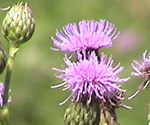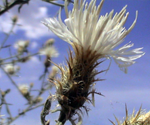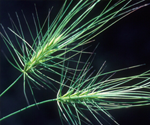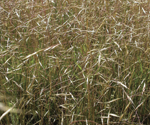At his last count, State Weed Coordinator Steve Ryder of the Colorado Department of Agriculture (CDA) set the number of regular old weeds found in the Centennial State’s landscapes at around 400 species. From dandelions to common mallow and clover, many weeds can be frustratingly persistent in yards and gardens but aren’t considered noxious.
Noxious weeds are the non-native aggressive invaders that replace native vegetation, reduce agricultural productivity, cause wind and water erosion, and pose an increased threat to communities from wildfire. They are less common in well-maintained, formal gardens and yards, but may be introduced accidentally by unknowing consumers or pets returning from open spaces and wilderness.
“It’s usually the wilder spaces, native gardens, large agricultural acreage, and public open spaces that end up with some of the rarer noxious weeds,” Ryder said.
Colorado has a few species of invasive grasses on the noxious weed list, including the very familiar cheatgrass which has been detected in almost all counties of the state. It is often a contaminant in native seed mixes and can be difficult to remove. Cheatgrass may eventually be surpassed in the near future by the arrival of even more invasive grass species such as ventenata and medusahead rye. The state is hoping to identify these newcomers early so we can minimize the impacts to native grasslands.
Weeds in waterways are a big concern since the vast majority of Colorado’s ecological diversity happens in and around water, and riparian areas attract a variety of wildlife as well as humans, he said.
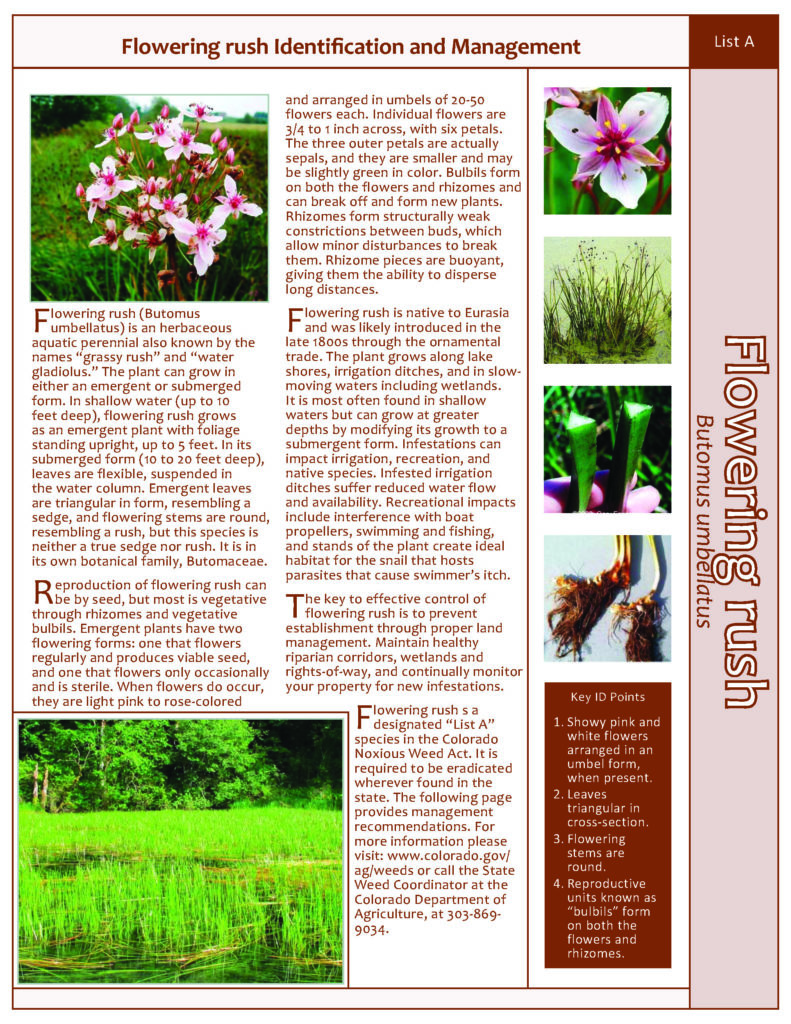
“A lot of the aquatic nuisance species, both listed and not, end up in irrigation canals and ponds and can certainly be a headache but they are probably not commonly sold. They are probably more of hitchhikers on other more common plants,” he explained.
Noxious weeds are found at high elevations around timberline, too. Often they originate in native and wildflower seed packets sold online, at garden centers and during wildflower festivals. Some just migrate uphill, like Canada thistle, which has been found as high as 12,000 feet on Independence Pass above Aspen.
“We would really like to have a dialog with all the nurseries and greenhouses as well as the water garden folks, just so we don’t introduce anything we regret later,” he added.
His office sees a “never-ending ebb and flow of plants” that raise concerns. “Some people will get freaked out about a plant, and then it disappears for a few years. We try to distinguish that sort of plant from those that are truly noxious and replace native plant communities,” he said.
One example of a worrisome but not disastrous weed is water hyacinth, which has been found in Colorado for years. This invasive species is typically unable to survive the state’s winters, so is controlled by the weather and not considered noxious since its spread is curtailed each year. Still, if it escapes and starts to survive winters, we would need to act quickly to control it.
Russian sage is another plant that causes concern due to its aggressive spreading. Some weed managers, such as one of Ryder’s colleagues in Wyoming, have talked about designating it as a noxious weed. However, Russian sage is a popular and pretty landscaping plant that sells well.
“We’re keeping our eyes and ears open to see how people are dealing with it. So far, it doesn’t seem to pose a huge threat,” he said.
If it starts being found in drainage areas such as where stormwater empties into natural areas, then he and the CDA staff would reconsider the plant’s classification.
“We don’t want to be overzealous in prohibiting every new plant out there because they are not all bad. Our goal is to prohibit the ones that are a possible menace,” he concluded.
A Brief Introduction to Noxious Weeds in Colorado
The Colorado Department of Agriculture classifies noxious weeds into four categories based on the recommended and sometimes regulated action when they are found. Many of these plants or related varieties are also listed on New Mexico’s noxious weed list. One asterisk indicates the same variety is listed, two asterisks indicate a different variety is listed, and three indicates both the same and additional varieties are listed in New Mexico.
In Colorado, 25 species are on List A and designated for eradication. A few examples are:
- RECENT ADDITION: Flowering rush (Butomus umbellatus): Primarily from the Northwest U.S., it was found in Grand Junction in 2018 – the first sighting in the entire Colorado River basin between here and Mexico. Beautiful but impossible to kill with herbicides or by manual removal, it clogs waterways and negatively impacts irrigation. If you find it, please report to the CDA.
- Myrtle spurge (Euphorbia myrsinites), leafy spurge* (Euphorbia esula): Very successful garden ornamentals, plants are capable of projecting seeds up to 13 feet or more. They grow from taproots. One large leafy spurge plant can produce up to 130,000 seeds.
- Mediterranean sage (Salvia aethiopis): A shrub that has escaped gardens and become a real problem in nature, the stem breaks off in the fall and forms a tumbleweed dispersing thousands of seeds. Mature plants can produce 100,000 seeds each.
- Purple loosestrife* (Lythrum salicaria): Introduced to North America as an ornamental plant, it escaped into natural areas such as streambanks and shallow ponds. This invasive plant reproduces primarily by seed, but root or stem pieces also can produce new plants. A single, mature plant can produce up to three million seeds per year, and the seeds can remain viable in the soil for 5 to 20 years.
- Meadow knapweed (Centaurea x moncktonii): See knapweed description in List B.
- Yellow starthistle*** (Centaurea solstitialis): See thistle description in List B.
List B consists of 38 species that are targeted for control to stop their further spread. A few notable examples are:
- Canada thistle* (Cirsium arvense), bull* thistle (Cirsium vulgare), musk* thistle (Carduus nutans), plumeless thistle (Carduus acanthoides), Russian thistle (Acroptilon repens), Scotch* thistle (Onopordum acanthium): Non-native, deep-rooted perennials, they spread by seeds and aggressive creeping, horizontal roots.
- Diffuse knapweed* (Centaurea diffusa), hybrid knapweed (Centaurea x psammogena = C. stoebe x C. diffusa), Russian* knapweed (Acroptilon repens), spotted* knapweed (Centaurea stoebe): Reproducing from massive amounts of seeds, these invasive plants choke out native vegetation.
- Hoary cress* (Lepidium draba): Commonly known as whitetop, this invasive plant is a creeping perennial and a member of the mustard family. It is very aggressive, blooms early, can form a monoculture, and really takes over when mowed.
- Oxeye daisy (Leucanthemum vulgare): A biological desert, very few insects or wildlife benefit from it. The plant spreads from roots, root fragments, or seeds. One flower head can produce up to 200 seeds, which may be viable up to 38 years or more.
- Yellow toadflax* (Linaria vulgaris), dalmation toadflax* (Linaria dalmatica & genistifolia), hybrid toadflax (Linaria vulgaris x L. dalmatica): Plants develop extensive root systems, and displace desirable plant communities reducing ecological diversity especially in mountain areas. They decrease forage and habitat for domestic livestock and some big game species.
List C consists of 16 species targeted for integrated weed management on private and public lands. The goal of such plans is not to stop the continued spread of these species but to provide additional education, research, and biological control resources. See the listed species at the link below.

There are 19 Watch List Species that have been determined to pose a potential threat to the agricultural productivity and environmental values of properties. This list is intended to serve advisory and educational purposes only, encouraging the identification and reporting of these species to the CDA. These reports can assist the agricultural commissioner in determining which species should be designated as noxious weeds. See this list at the link below.
Full lists of plants designated by the CDA as noxious weeds:
https://drive.google.com/file/d/0Bxn6NtpJWc9JRFE3LW1RWFVXY1E/view
Fact sheets on each plant:
https://www.colorado.gov/pacific/agconservation/noxious-weed-species
FAQs, maps, publications, county weed programs, etc.:
www.colorado.gov/ag/weeds
Colorado noxious weed identification mobile app for IOS and Android.
New Mexico Listed Noxious Plants (32 plants):
https://plants.usda.gov/java/noxious?rptType=State&statefips=35
*Also listed in New Mexico as noxious weeds
**Related varieties listed in New Mexico
***Also listed in New Mexico as well as related varieties Note: Also see related article on How to Help Customers with Weed Problems



